
Symphyotrichum ontarionis (Ontario Aster) on 10-25-21, #852-20.
Ontario Aster, Bottomland Aster
Symphyotrichum ontarionis
(Symphyotrichum ontarionis var. ontarionis)
sim-fy-oh-TRY-kum
Symphyotrichum ontarionis (1) (Updated on 12-4-23 from Plants of the World Online): Aster ontarionis Wiegand
Synonyms of Symphyotrichum ontarionis var. ontarionsis (7) (Updated on 3-21-23 from POWO): Aster diffusus var. thyrsoideus A.Gray, Aster lateriflorus var. thyrsoideus E.Sheld., Aster missouriensis var. thyrsoideus Wiegand, Aster ontariensis Wiegand, Aster pantotrichus S.F.Blake, Aster pantotrichus var. thyrsoideus S.F.Blake, Aster tradescanti var. thyrsoideus (A.Gray) B.Boivin
Symphyotrichum ontarionis (Wiegand) G.L.Nesom is the accepted Scientific name for the Ontario Aster. It was named and described as such by Guy L. Nesom in Phytologia in 1995. It was first named Aster ontarionis by Karl McKay Wiegand in Rhodora in 1928.
Accepted Infraspecific Names (2) (Updated on 12-4-23 from POWO): Symphyotrichum ontarionis var. glabratum (Semple) Brouillet & Bouchard, *Symphyotrichum ontarionis var. ontarionis (autonym). *When an infraspecific taxon is named, an autonym (“type-specimen”) is automatically generated whose description is closest to the (original) species. All have their own list of synonyms… Symphyotrichum ontarionis var. ontarionis is the species found in Missouri where I live.
The genus, Symphyotrichum Nees, was named and described as such by Christian Gottfried Daniel Nees von Esenbeck in Genera et Species Asterearum in 1832.
As of 12-4-23 when this page was updated, Plants the World Online by Kew lists 100 species in the Symphyotrichum genus. It is a member of the plant family Asteraceae with 1,702 genera. Those numbers could change as updates are made on POWO. The number of genera in this family fluctuates quite often.

Distribution map for Symphyotrichum ontarionis from the USDA Plants Database. Published on the internet at https://plants.sc.egov.usda.gov/home. Retrieved on October 29, 2021.
The above distribution map for Symphyotrichum ontarionis is from the USDA Plants Database. Areas in green are where the species is native. The map on Plants of the World Online is somewhat different. You can click on the link to POWO to view the map for Symphyotrichum ontarionis var. glabratum. The USDA Plants Database still lists it as a synonym…
The map on iNaturalist shows where members have made observations. Anyone can join and it is a great website to confirm and share your observations. The maps on iNaturalist are continually updated as members post new observations.
THERE ARE SEVERAL LINKS AT THE BOTTOM OF THE PAGE FOR FURTHER READING AND TO HELP WITH A BETTER POSITIVE ID.

Symphyotrichum ontarionis (Ontario Aster) on 10-25-21, #852-21.
I found this plant growing in an area behind the pond along the fence in the back pasture of the farm. The same day, I found another species I was very confused about growing on the banks of the drainage ditch for the pond. I posted photos of both plants on iNaturalist. I thought this one was likely Symphyotrichum lanceolatum (Panicled or Tall White Aster) but that turned out to be incorrect. I contacted a member of iNaturalist who referred me to another member (both curators) who is good with the Symphyotrichum genus. He agreed with my thoughts about the other one being S. lateriflorum (Calico Aster) and suggested this one is S. ontarionis (Ontario Aster). I agreed and they both became Research Grade. The member also said it could be an aberrant S. lateriflorum. I will have to keep an eye on both in 2022.
There are more photos at the bottom of the page under the links for further reading.
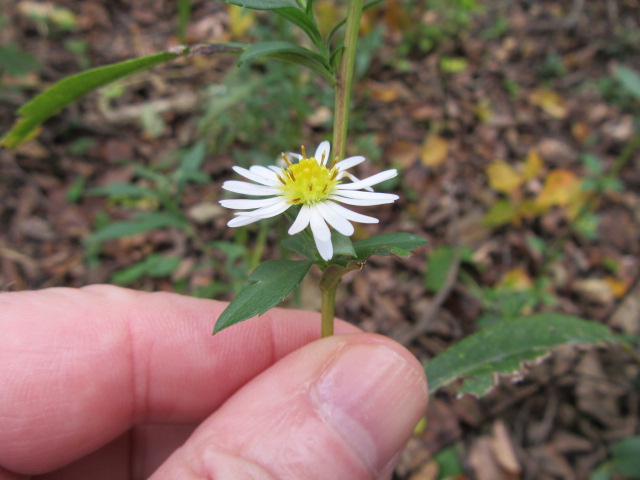
Symphyotrichum ontarionis (Ontario Aster) on 10-25-21, #852-22.
Symphyotrichum ontarionis is a perennial wildflower in the plant family Asteraceae. It isn’t as common as many other members in the genus and is commonly misidentified. You can look at maps online which are often misleading and out of date. Species do get around are are commonly more widespread than maps show, but they also disappear in areas where they once thrived.
This species prefers partial shade to dappled sun in wooded areas in fertile, fairly damp soil. They can be found along streambanks, around pond margins, low areas in the woods, open woods, along ditches, etc. Although they prefer loamy soil, other soil types are somewhat tolerated. The only place I have found this species is behind the pond bank in a wooded area at the back of the pond (between the bank and boundary fence).
The stems of Symphyotrichum ontarionis grow from long slender branched rhizomes. The stems grow upright then lean to one side (ascending). Depending on conditions, if you hold the plant upright, the length (or height) can be up to 3-4’. Sometimes deer or cattle may snip off the stem before it reaches that size. The stems normally branch out toward the midpoint and are sparsely to moderately pubescent (hairy) with short, spreading hairs. Sometimes these hairs are only in longitudinal lines above the midpoint. During the flowering period, secondary branches emerge from the leaf axils. The main stem and branches may be rather thin and spindly in more shady areas.

Symphyotrichum ontarionis (Ontario Aster) on 4-18-22, #869-8.
There are several types of leaves depending where they are on the plant. The first leaves to appear in the spring are called basal leaves and, when small, may have smooth margins and appear glaucous (without hairs). They will be oblanceolate to obovate in shape and taper toward the base. They are generally sessile (no petiole or leaf stem), even though the younger leaves may appear petiolate.

Symphyotrichum ontarionis (Ontario Aster) on 5-28-22, #885-50.
The leaves grow in an alternate pattern along the stems and are lanceolate, oblanceolate, to narrowly obovate in shape.
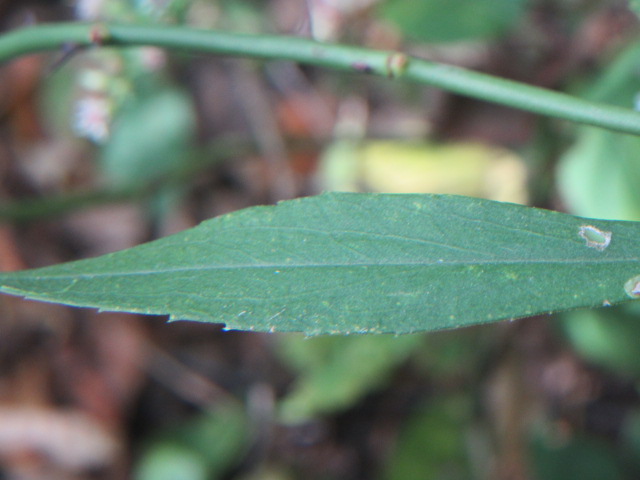
Symphyotrichum ontarionis (Ontario Aster) on 10-9-22, #916-34.
The tips of the leaves may end in a sharp or blunt point, the margins can be bluntly to sharply toothed. The leaves taper to a hard to explain petiole-like, slightly winged base. The upper surface of the leaves are hairless (glabrous) or have very fine short hairs giving them a soft feel. The small hairs on the undersurface may be longer along the veins.

Symphyotrichum ontarionis (Ontario Aster) on 8-8-22, #903-28.
The above photo was taken on August 8 in 2022 and shows how the plants branch out toward the top. The outward branching stems are where the flowers will appear. You can see the leafy bracts along the stems. The flowers tend to move around the stems toward the light or they grow only on one side like the S. lateriflorum. They really don’t produce that many flowers compared to other species in the genus that prefer full sun.

Symphyotrichum ontarionis (Ontario Aster) on 10-11-22, #917-4.
The stems terminate in branch-like loosely ascending to spreading panicles of flower heads.

Symphyotrichum ontarionis (Ontario Aster) on 10-11-22, zoomed in screenshot of #917-5.
The flower heads consist of 15-25 white ray florets (petals), and 12-25 disc florets. The flower heads are about 1/2” wide. The tubular disc florets have 5 spreading lobes at the tip and are pale yellow in color that turn reddish purple.

Symphyotrichum ontarionis (Ontario Aster) on 10-11-22, #917-6.
The flower heads are subtended by an involucre with involucral bracts (phyllaries) in 3-5 overlapping series. The flowering branches have numerous leafy bracts.
The flowering period is from August to October…
Fertilized flower heads are replaced by clusters of small seeds (achenes). The achenes have white hairs at their apex and are distributed by the wind.
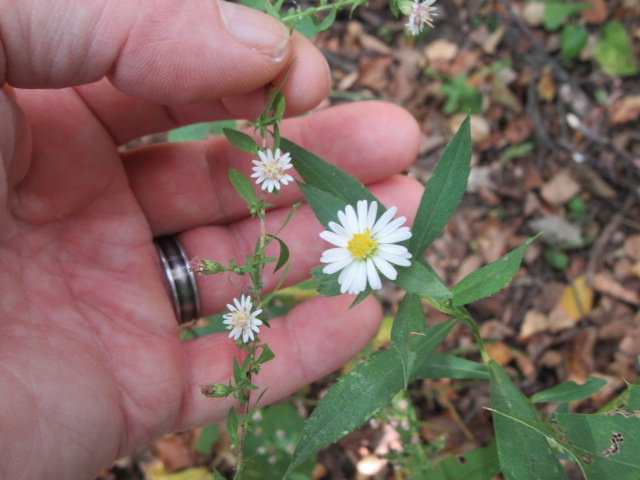
Symphyotrichum ontarionis (Ontario Aster) on the right and S. lateriflorum (Calico Aster) on the left on 10-9-22, #916-32.
The above photo is a comparison between the Symphyotrichum ontarionis (on the right) and Symphyotrichum lateriflorum on the left. The colony of S. lateriflorum grows along the banks of the drainage ditch that drains the overflow from the north pond. The S. ontarionis is in an area behind the second pond along the boundary fence. I believe my grandpa was planning on joining the two ponds, but the second one must filled with water from a spring before it was finished. It is weird, but the water in the original pond is clear (and dries up in the summer), while the water in the second pond is always a brownish color and never dries up…
Members of the Symphyotrichum genus can be quite complicated. I “think” I have identified six species and there is another one or two I haven’t quite figured out…
I will continue taking more photos of this species. The flowers are small, and being in a shady area sometimes doesn’t help. Practice makes perfect. 🙂
I have enjoyed photographing and learning about the many wildflowers growing on the farm I live on and in other areas. The farm I live on is in Windsor, Missouri in Pettis County (Henry County is across the street and Benton and Johnson aren’t far away). I have grown over 500 different plants and identified over 250 species of wildflowers (most have pages listed on the right side of the page). I am not an expert, botanist, or horticulturalist. I just like growing, photographing, and writing about my experience. I rely on several websites for ID and a few horticulturalists I contact if I cannot figure them out. Wildflowers can be somewhat variable from location to location, so sometimes it gets a bit confusing. If you see I have made an error, please let me know so I can correct what I have written.
I hope you found this page useful and be sure to check the links below for more information. They were written by experts and provide much more information. Some sites may not be up-to-date but they are always a work in progress. If you can, I would appreciate it if you would click on the “Like” below and leave a comment. It helps us bloggers stay motivated. You can also send an email to me at thebelmontrooster@yahoo.com. I would enjoy hearing from you especially if you notice something is a bit whacky.
FOR FURTHER READING:
PLANTS OF THE WORLD ONLINE (GENUS/SPECIES)
INTERNATIONAL PLANT NAMES INDEX (GENUS/SPECIES)
TROPICOS (GENUS/SPECIES)
FLORA OF MISSOURI (GENUS/SPECIES)
FLORA OF NORTH AMERICA (GENUS/SPECIES)
WORLD FLORA ONLINE (GENUS/SPECIES)
WIKIPEDIA (GENUS/SPECIES)
USDA PLANTS DATABASE
MISSOURI PLANTS
iNATURALIST
WILDFLOWER SEARCH
ILLINOIS WILDFLOWERS
MINNESOTA WILDFLOWERS
GO BOTANY
LADY BIRD JOHNSON WILDFLOWER CENTER
FRIENDS OF THE WILDFLOWER GARDEN
ONTARIO WILDFLOWERS
NOTE: The data (figures, maps, accepted names, etc.) may not match on these websites. It depends on when and how they make updates and when their sources make updates. Some websites have hundreds and even many thousands of species to keep up with. Accepted scientific names change periodically and can be hard to keep with. Some of the links may use a name that is a synonym on other sites. In my opinion, Plants of the World Online by Kew is one of the most reliable and up-to-date plant databases and they make updates regularly. I make updates “at least” once a year and when I write new pages or add new photos but I do get behind. We are all a work in progress. 🙂
MORE PHOTOS…
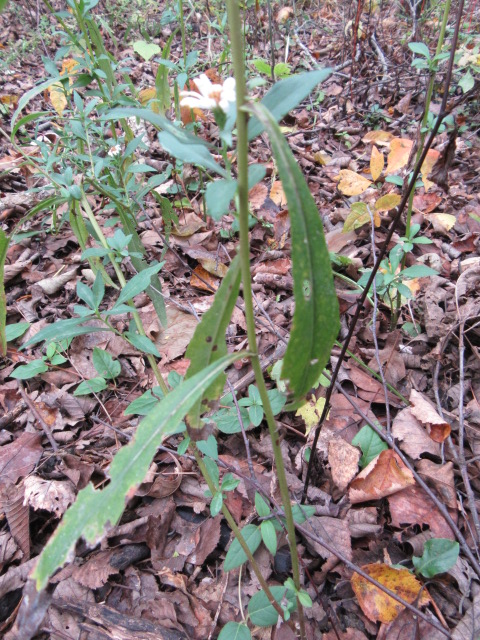
Symphyotrichum ontarionis (Ontario Aster) on 10-25-21, #852-23.
There were still quite a few long, narrow leaves on this plant but the upper leaves are completely different than those on the Symphyotrichum lateriflorum along the ditch…

Symphyotrichum ontarionis (Ontario Aster) on 10-25-21, #852-24.

Symphyotrichum ontarionis (Ontario Aster) on 4-18-22, #869-9.

Symphyotrichum ontarionis (Ontario Aster) on 4-18-22, #869-10.

Symphyotrichum ontarionis (Ontario Aster) on 5-28-22, #885-48.

Symphyotrichum ontarionis (Ontario Aster) on 5-28-22, #885-49.

Symphyotrichum ontarionis (Ontario Aster) on 6-26-22, #896-27.
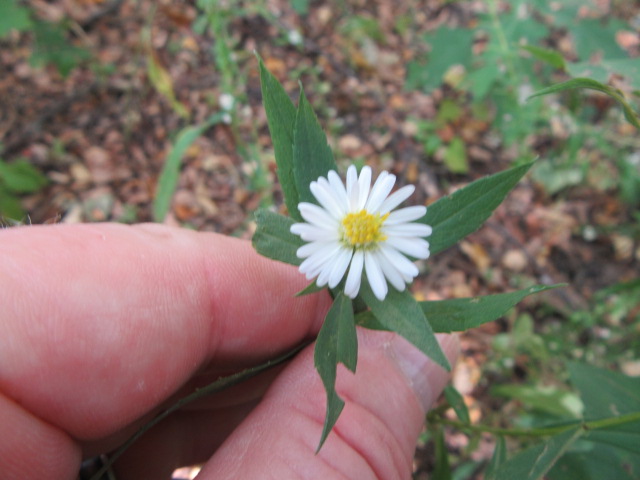
Symphyotrichum ontarionis (Ontario Aster) on 10-9-22, #916-31.

Symphyotrichum ontarionis (Ontario Aster) on 10-9-22, #916-33.

Symphyotrichum ontarionis (Ontario Aster) on 10-11-22, #917-5.

Symphyotrichum ontarionis (Ontario Aster) on 10-11-22, #917-7.
It was getting kind of late when the above and below photos were taken. For curiosity, I used a flash…

Symphyotrichum ontarionis (Ontario Aster) on 10-11-22, #917-8.

Symphyotrichum ontarionis (Ontario Aster) on 10-11-22, #917-9.